Damit die Richtung stimmt
Die Lenkbarkeit von Geräten und Maschinen ist abhängig von der Position der einzelnen Rollen. Verschiedene Möglichkeiten der Anordnung zeigen, in welche Richtung es gehen kann:
Die Lenkbarkeit von Geräten und Maschinen ist abhängig von der Position der einzelnen Rollen. Verschiedene Möglichkeiten der Anordnung zeigen, in welche Richtung es gehen kann:

In swivel castors, the wheel and fork can rotate through a full 360 degrees, whilst the top or mounting plate remains in a fixed position. The horizontal distance between the centreline of the swivel and the centreline of the wheel is called the offset. When pressure is applied through the mounting plate, the offset causes the castor to swivel in line so that the wheel always trails in the opposite direction to the way in which the equipment is being moved.

Fixed castors have the top plate rigidly fastened to the fork legs with the wheel in line with the fixing bolt holes. These castors do not swivel at all and the wheel can only move in two directions; forwards and backwards.
Our tables give the swivel radius dimension for all swivel castors. This shows the mounting clearance required to allow the castor to swivel without obstruction.
Swivel head seals are fitted as standard to scaffold castors and all 5, H, P, X, Y and Z series castors. They are optional on the 3 and 4 series.
All castor bearings are correctly adjusted when the castor is built and should require no attention other than greasing, and then only when they are subjected to particularly ardous conditions.
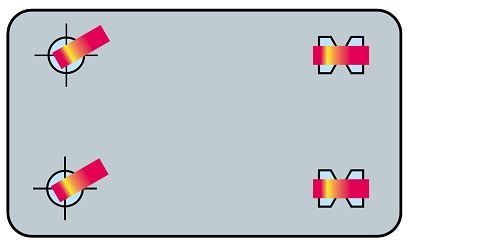
Providing good load capacity and manoeuvrability, this combination ensures accurate steering, even on long straight runs, making it the most practical combination for industrial use. Any trolley with this castor combination should be pushed with the fixed castors leading.
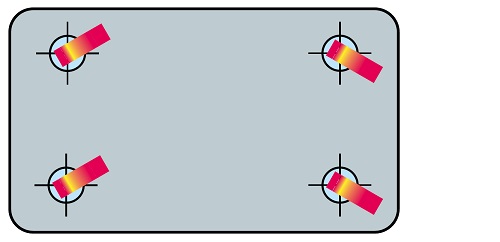
As this combination gives good load capacity with exceptional manoeuvrability, it is suitable for winding runs where sideways action is required. It is not recommended for straight runs or ramps, as it may be hard to guide, especially over bumpy terrain and when heavily loaded. However, equipping two castors with directional locks makes this arrangement very versatile and suitable for long straight runs.

This combination provides an economical solution for lightly loaded trolleys requiring good manoeuvrability. The trolley must be reasonably small in size and any load must be evenly distributed to ensure stability.
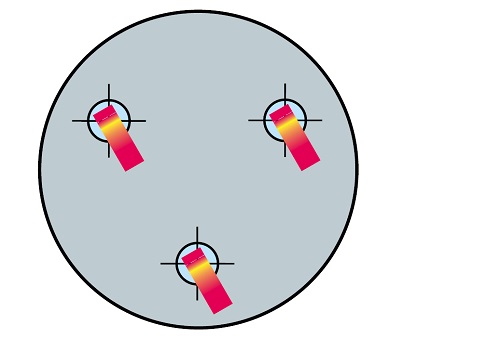
This provides good load capacity with excellent manoeuvrability. However, equipment with this arrangement will be difficult to guide on straight runs particularly over uneven ground. This arrangement is ideal for barrel dollies and small portable machines.
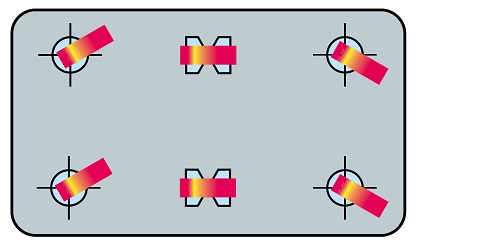
This combination provides an extremely high load capacity, with great manoeuvrability and stability. This is ideal for very long trolleys designed to carry heavy loads - the fixed castors can be replaced by wheels mounted onto a central axle. The unit's base must be robust and the swivel castors are mounted to allow the trolley to pivot on the central wheels. Therefore, 25mm of packing is required above the two fixed castors (wheel) to give alternating load support, depending on which pair of wheels is in contact with the floor. The entire loads rests on 2 central, fixed castors/wheels.
Please note that the swivel castors are subjected to shock loads if the trolley is tipped or the load is not evenly distributed.
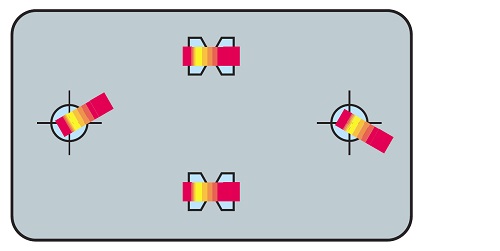
Ideal for confined spaces, this configuration provides good load capacity with excellent manoeuvrability. The fixed castors can be replaced by wheels which pivot the trolley centrally. In this case, 25mm of the packing is necessary above the two fixed castors (wheels) to give alternating load support. However, if the trolley is tipped or the load is not evenly distributed, the swivel castors are subjected to shock loads.
The entire load rests on the 2 central, 2 fixed castors/wheels.
